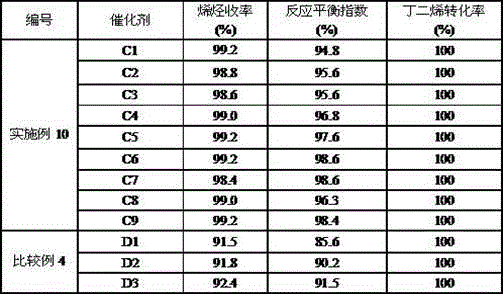Catalyst and method for preparing butene-2 through butene-1 hydroisomerization
A technology for hydroisomerization and catalyst, which is applied in the fields of isomerization to produce hydrocarbons, chemical instruments and methods, metal/metal oxide/metal hydroxide catalysts, etc. The problems of low hydroisomerization conversion rate and low total olefin yield can achieve the effects of high reaction space velocity, helpful reaction selectivity and water resistance, and low olefin hydrogenation rate.
- Summary
- Abstract
- Description
- Claims
- Application Information
AI Technical Summary
Problems solved by technology
Method used
Image
Examples
Embodiment 1
[0021] Weigh 30 grams of pseudo-boehmite, 150 grams of θ-alumina, 5 grams of δ-alumina, and 9 grams of scallop powder, mix them, and then add 20 grams of polyvinyl alcohol-containing solution (mass concentration: 5%), the concentration 4.0 grams of 68% nitric acid, 300 ml of aqueous solution, extruded into a clover-shaped carrier with a diameter of 2.5 mm, and the wet strip was passed through 120 o C dried for 4 hours at 750 o C was calcined for 4 hours to obtain carrier Z1. The carrier composition is shown in Tables 1 and 2, and the carrier properties are shown in Table 3. The carrier is impregnated in an equal amount of impregnation solution with a nickel content of 8%, 60 o C drying for 8 hours, 450 o C was calcined for 4 hours to obtain Ni-based catalyst C1. The catalyst composition is shown in Table 4, wherein the contents of each component are based on catalyst weight.
[0022]
Embodiment 2
[0024] Weigh 30 grams of pseudo-boehmite, 150 grams of θ-alumina, 20 grams of δ-alumina, 9 grams of scallop powder, 10 grams of diatomaceous earth, mix, and then add polyvinyl alcohol-containing solution (mass concentration is 5 %) 20 grams, 4.0 grams of nitric acid with a concentration of 68%, 300 milliliters of aqueous solution, extruded into a clover-shaped carrier of φ2.5 mm, wet strips after 120 o C dried for 4 hours at 750 o C was calcined for 4 hours to obtain carrier Z2. The composition of the carrier is shown in Tables 1 and 2, and the properties of the carrier are shown in Table 3. The carrier is impregnated in an equal amount of impregnation solution with a nickel content of 10%, 60 o C drying for 8 hours, 450 o C was calcined for 4 hours to obtain Ni-based catalyst C2. The catalyst composition is shown in Table 4, wherein the contents of each component are based on catalyst weight.
[0025]
Embodiment 3
[0027]Weigh 30 grams of pseudo-boehmite, 140 grams of θ-alumina, 45 grams of δ-alumina, 9 grams of scallop powder, 30 grams of diatomaceous earth, mix, and then add a solution containing polyvinyl alcohol (mass concentration of 5 %) 20 grams, 4.0 grams of nitric acid with a concentration of 68%, 1.2 grams of magnesium nitrate, 310 ml of aqueous solution, extruded into a clover-shaped carrier with a diameter of 2.5 mm, and the wet strip was passed through 120 o C dried for 4 hours at 750 o C was calcined for 4 hours to obtain carrier Z3. The carrier composition is shown in Tables 1 and 2, and the carrier properties are shown in Table 3. The carrier is impregnated in equal amounts in an impregnating solution with a metal nickel content of 12% and a metal molybdenum content of 0.1%, 60 o C drying for 8 hours, 450 o C was calcined for 4 hours to obtain Ni-based catalyst C3. The catalyst composition is shown in Table 4, wherein the contents of each component are based on catalys...
PUM
| Property | Measurement | Unit |
|---|---|---|
| specific surface area | aaaaa | aaaaa |
| pore size | aaaaa | aaaaa |
Abstract
Description
Claims
Application Information
 Login to View More
Login to View More - R&D
- Intellectual Property
- Life Sciences
- Materials
- Tech Scout
- Unparalleled Data Quality
- Higher Quality Content
- 60% Fewer Hallucinations
Browse by: Latest US Patents, China's latest patents, Technical Efficacy Thesaurus, Application Domain, Technology Topic, Popular Technical Reports.
© 2025 PatSnap. All rights reserved.Legal|Privacy policy|Modern Slavery Act Transparency Statement|Sitemap|About US| Contact US: help@patsnap.com



